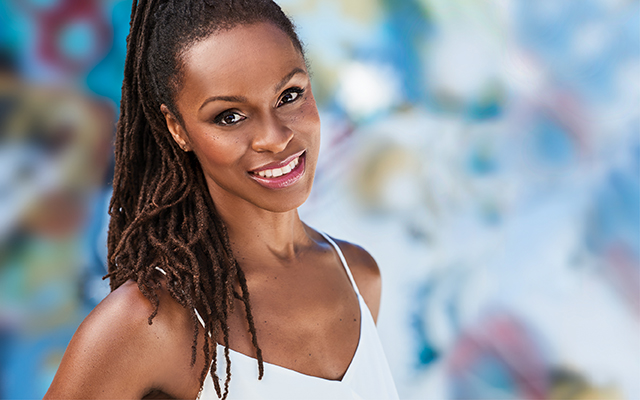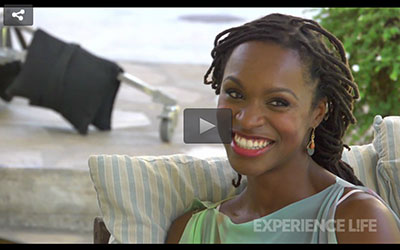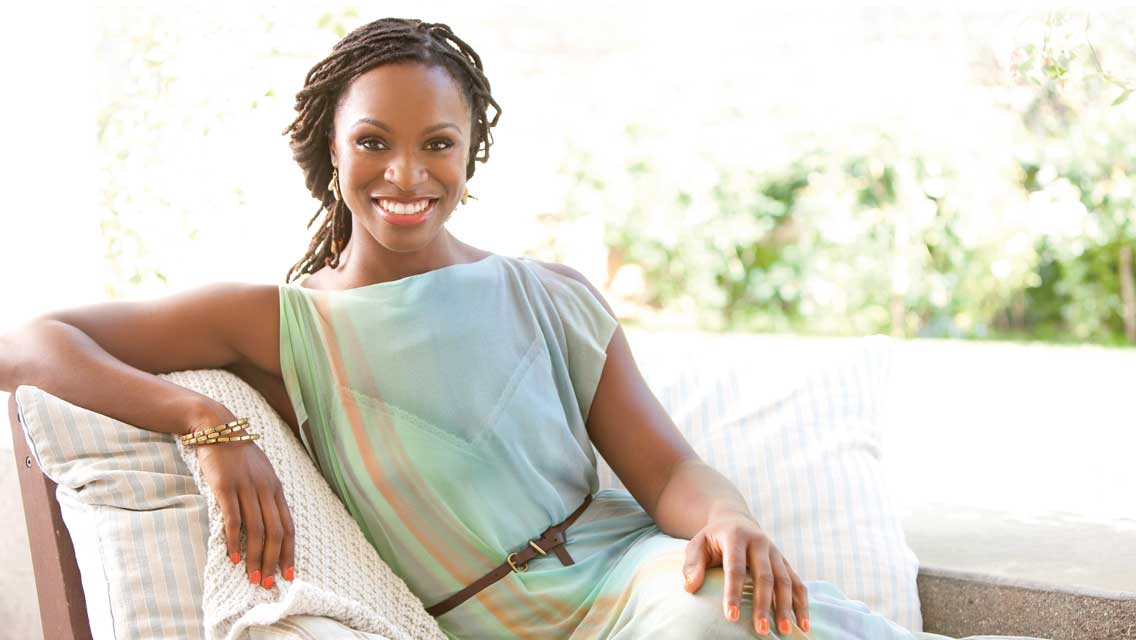Latham Thomas is on a mission to help women reach their full potential.
“I want to build a movement that empowers women to reclaim their bodies as sacred, to embrace self-care, and use their intuition as a source of power,” the 37-year-old wellness maven, best-selling author, and doula says. “I want to help women give birth to their dreams.”
The Columbia University and Institute for Integrative Nutrition graduate knows a thing or two about delivering on her goals. Along with being a birth and plant-based-nutrition coach, her accomplishments include founding a holistic lifestyle practice and authoring two books.
The most recent, Own Your Glow, was released in September. Thomas calls it a guide for helping women on the precipice of any change in their lives to return home to themselves and the power that resides within.
Her degree and training in visual arts deeply inform Thomas’s experience and outlook. “Owning your glow is about bringing everything into the light, because the divine lives in dark places,” she explains. “It’s also about embracing the parts of yourself you were told weren’t beautiful or good enough, or were too harsh, and really loving who you are.”
The techniques and tips she shares are the same ones the practicing yogi uses herself to stay balanced. “It’s normal to have ruts and ride emotional waves,” says Thomas. “But practices like meditation and yoga help me slow down and figure out where I exist in every ecosystem. They allow me to parse what matters most so that I can put my energy there with as much intention and love as possible.”
Q&A With Latham Thomas
Experience Life | What does it mean to “own your glow”?
Latham Thomas | Glowing is about radiance, abundance, living in light, and being the best iteration of yourself.
In this book, I wanted to talk about how feminine luminosity can create a movement among women for reclaiming their bodies as sacred, embracing self-care, and using their intuition as a source of power to their dreams.
I wanted to share affirmations, rituals, and ancient practices, like meditation, that women can use to frame their lives in a way that makes every moment sanctified and holy. We can have that!
We don’t have to feel rushed or live counter to what our spirit, the universe, or God wants. While not every moment is going to be easy, we can feel more at ease in every moment.
Even if you live in a fast-paced society, there are ways to calibrate and to learn to take deep breaths and make more-intentional movement.
EL | One way you say we can own our glow is by challenging the stories we create about who we are, what we can be, and what we can have. How do we do this?
LT | One exercise I offer to readers in the book is to look at their negative thought patterns and beliefs as weeds. They’re like weeds because we allow them to become pervasive. I think it’s good to set aside time regularly to pick the weeds by reflecting on what to keep, nurture, and grow, and what to pull out of the garden.
You can do this by questioning what lessons you’ve learned that are no longer of service to your mission. Or ask yourself whether a seed that may have been planted by someone else has been allowed to grow without you realizing it.
You can also look at thoughts and beliefs like traveling: When you pack for a trip, you don’t take your entire house. You take the things you know you need for where you’re going. Life is like this. You don’t want to show up to the airport of life, weigh your bag, and be told that you have too much to take where you’re going. You also don’t want to take more than you can carry — you can’t fly if you’re weighed down.
EL | You talk a lot about the importance of expanding our capacity to receive. What prevents us from receiving?
LT | Again, I think it’s key to examine our thoughts — in this case, around what we believe is possible. Unfortunately, many of us have been told, “Oh, you can’t have this career or life you want.” Or maybe you see someone on social media and think, Wow, look at this amazing life they created for themselves. I can’t have that.
Expanding our capacity to receive is about questioning ourselves to find out when we are making a fist instead of holding out an open palm.
When I was younger, all of my romantic relationships lasted the exact same amount of time — three months would be the expiration date. As I was talking to a friend once about my relationships, and how I always found a way to sabotage them, my friend asked, “Latham, do you believe that you deserve to be loved? Like, deep down do you believe it?” And I sat with that. I started crying and said no.
It was then that I knew I had to interrogate all the reasons that made me think I was unlovable. I began to look at the patterns I fell back on and the behaviors I used as a crutch. It’s OK to walk with crutches if you’re injured, but if you’re not, you need to prop yourself up.
Start by giving yourself what you need, and eliminate what you don’t need. Once you do that, you can begin giving to others and they will give to you. We expand through love and kindness.
EL | What are other ways to break through our entrenched patterns?
LT | There are many healthy tools outside of ourselves — like therapy — that can be of assistance. It’s always good to have a friend or family member you can turn to when you are feeling small to help you find your way back into your greatness.
I also love doing sister circles. These groups meet regularly and create space for people to be vulnerable and share their deepest desires and challenges. These are places that allow people to be witnessed and supported in their vulnerability. Men can also benefit from participating in such circles with other men.
Being vulnerable is an opportunity to practice being soft and supple in consciousness, and the more you open your heart, the easier it gets. The more you open up, the more you inspire others to do so.
EL | How is being vulnerable important to giving and receiving?
LT | We’re afraid to be vulnerable because we’re afraid to allow people to see the truth of who we are. It’s an opening that’s scary. But they also see you at your strongest at the same time. For example, when you see a mother at the threshold of giving birth, she is at her most vulnerable and her most powerful.
Once people see that vulnerability is the most powerful and human place to operate from — because people relate to and believe in you when you’re vulnerable — they can create better personal and work relationships as well as better communities and societies. Being vulnerable and witnessing it expands our capacity for love, empathy, compassion, and joy. It expands our ability to receive — and to give.




This Post Has 0 Comments